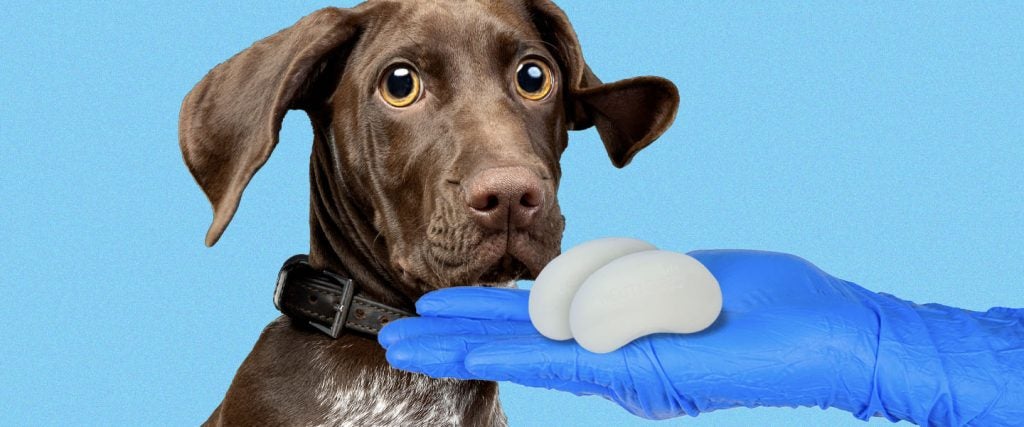In 1993, Gregg Miller, an inventor and entrepreneur, briefly lost his 200-pound Bloodhound, Buck, who’d apparently taken off after catching the scent of a female dog in heat. Fortunately, Buck was found four worry-filled days later, but Miller knew he needed to neuter him, or else it would happen again — after all, removing a dog’s balls lowers their libido. Still, he didn’t want to put the pooch or himself through that experience. What’s more, he didn’t want Buck to miss his nuts.
This got Miller thinking, and he asked his vet if there were implants “so Buck could maintain his god-given look.” Initially, the vet thought his idea was crazy, so Buck had his balls removed without a replacement.
Miller tells me Buck grieved that loss and was depressed for weeks. “He went to the spot in the house where he went when he didn’t feel well,” he says. “He sat up and went to lick his private area, which was one of his favorite things to do. When he did, he quickly looked up at me, looked back down at that area, then looked again at me as if to say, ‘Where are they?’”
However, when Miller brought Buck back to have his stitches removed, the vet had warmed up to the idea. Together, they invented Neuticles, prosthetic testicular implants for animals.
Miller says he maxed out his credit cards and the mortgage on his home to help fund his creation. Altogether, he and his investors spent over $100,000 to develop the fake balls, and in 1995, a Rottweiler named Max became the first animal to have them implanted.
Bizarre as Neuticles may sound, Miller’s dedication seems to have paid off. He claims to have sold over 500,000 sets, which have been implanted in dogs, cats, horses, primates, bulls, water buffalo and even rodents in a whopping 62 countries. Furthermore, mega-celebrities like Kim Kardashian and Jake Gyllenhaal have had Neuticles implanted into their decidedly pampered dogs. Miller was even granted the Ig Nobel Prize for medicine in 2005. As a result, he’s now a dog-ball millionaire.
According to Miller, Neuticles come in four models and nine sizes, which range in price from $159 to $689. He says the expensive ones have a more natural feel and are less likely to result in the formation of scar tissue, whereas the cheap ones can feel unnaturally hard to the touch. (Before some tinkering, the original Neuticles sometimes made a “clunking” sound when the dogs they were implanted into walked or sat down.)
Those willing to pay extra can hire Miller to make custom testicles, too. For example, he once created a watermelon-sized set for a zoo elephant, which cost $2,800.
As for the procedure itself, Miller claims that a vet once told him it’s as easy as changing a light bulb — you simply put the Neuticles in as you take the real testicles out. He also says Neuticles have never caused health complications or been rejected by an animal’s body. Depending on the model, they’re made of either solid silicone, which is generally considered safe for even human implantation, or FDA-approved polypropylene homopolymer, a type of plastic.
In fact, Miller believes that Neuticles improve the mental well-being of animals and their owners alike. “Neuticles are for pet owners who consider their pet to be a member of the family,” he tells me. “They’re pet owners that want their beloved pet to maintain their natural look and are opposed to the traditional form of altering, which turns a male dog into a eunuch.”
Perhaps most importantly, Miller says neuter-hesitant owners are more likely to neuter their pets when Neuticles are an option, “reducing the pet overpopulation issue.” Along those lines, he believes that his invention played a part in plummeting pet euthenasia rates.
Shawna Henri, a Utah resident, has had Neuticles implanted into three of her Weimaraners so far. While she purchased them for cosmetic reasons, she says men are especially less likely to neuter their dogs because they feel bad about taking away their nuts. That’s where she believes Neuticles can come to the rescue: “If everyone would spay and neuter their dogs, the world would be a better place,” she tells me.
Moreover, Henri believes it’s possible that dogs are smarter than we think, and that they’re aware when their balls are missing, which is another reason why she’s a fan of Neuticles. “If I were a dog and I were being neutered, I guess I’d like that,” she says, referring to the prosthetic nuts.
As for whether dogs really know, it’s hard to say. “We have to be careful not to anthropomorphize,” says Zazie Todd, animal psychologist and author of Wag: The Science of Making Your Dog Happy. “Although we know that dogs experience emotions, they’re not necessarily the same as human emotions, and it seems unlikely that dogs have ‘self-esteem’ linked to their private parts.” Therefore, she says any decisions about neutering and Neuticles should be made with a vet.
This question of whether Neuticles are more than just cosmetic is at the heart of the hate the product sometimes endures. But even if they’re only cosmetic, Miller says, “Gosh darnit, what’s wrong with that? If it’s good enough for humans, it should be good enough for pets.” Moreover, he adds, “When a veterinarian removes the pet’s testicles and leaves the pet unwhole, isn’t that cosmetic surgery?”
Because of these controversies, there are vets who won’t perform the Neuticle procedure, and it’s worth noting that other cosmetic procedures like tail docking and ear cropping are banned in various countries.
Regardless, Miller continues to support his creation. While Buck passed away in 2001, Miller’s new pup, a Bulldog named Humphrey, proudly sports his fake testes. And per Miller, Humphrey told him to tell me, “With Neuticles, it’s like nothing ever changed.”

